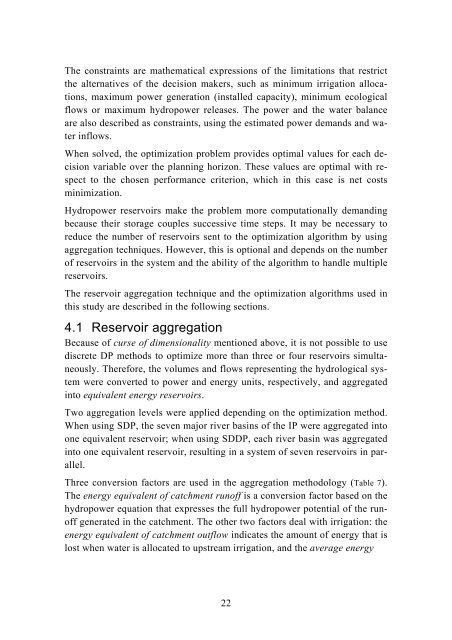A framework for joint management of regional water-energy ... - Orbit
A framework for joint management of regional water-energy ... - Orbit
A framework for joint management of regional water-energy ... - Orbit
You also want an ePaper? Increase the reach of your titles
YUMPU automatically turns print PDFs into web optimized ePapers that Google loves.
The constraints are mathematical expressions <strong>of</strong> the limitations that restrict<br />
the alternatives <strong>of</strong> the decision makers, such as minimum irrigation allocations,<br />
maximum power generation (installed capacity), minimum ecological<br />
flows or maximum hydropower releases. The power and the <strong>water</strong> balance<br />
are also described as constraints, using the estimated power demands and <strong>water</strong><br />
inflows.<br />
When solved, the optimization problem provides optimal values <strong>for</strong> each decision<br />
variable over the planning horizon. These values are optimal with respect<br />
to the chosen per<strong>for</strong>mance criterion, which in this case is net costs<br />
minimization.<br />
Hydropower reservoirs make the problem more computationally demanding<br />
because their storage couples successive time steps. It may be necessary to<br />
reduce the number <strong>of</strong> reservoirs sent to the optimization algorithm by using<br />
aggregation techniques. However, this is optional and depends on the number<br />
<strong>of</strong> reservoirs in the system and the ability <strong>of</strong> the algorithm to handle multiple<br />
reservoirs.<br />
The reservoir aggregation technique and the optimization algorithms used in<br />
this study are described in the following sections.<br />
4.1 Reservoir aggregation<br />
Because <strong>of</strong> curse <strong>of</strong> dimensionality mentioned above, it is not possible to use<br />
discrete DP methods to optimize more than three or four reservoirs simultaneously.<br />
There<strong>for</strong>e, the volumes and flows representing the hydrological system<br />
were converted to power and <strong>energy</strong> units, respectively, and aggregated<br />
into equivalent <strong>energy</strong> reservoirs.<br />
Two aggregation levels were applied depending on the optimization method.<br />
When using SDP, the seven major river basins <strong>of</strong> the IP were aggregated into<br />
one equivalent reservoir; when using SDDP, each river basin was aggregated<br />
into one equivalent reservoir, resulting in a system <strong>of</strong> seven reservoirs in parallel.<br />
Three conversion factors are used in the aggregation methodology (Table 7).<br />
The <strong>energy</strong> equivalent <strong>of</strong> catchment run<strong>of</strong>f is a conversion factor based on the<br />
hydropower equation that expresses the full hydropower potential <strong>of</strong> the run<strong>of</strong>f<br />
generated in the catchment. The other two factors deal with irrigation: the<br />
<strong>energy</strong> equivalent <strong>of</strong> catchment outflow indicates the amount <strong>of</strong> <strong>energy</strong> that is<br />
lost when <strong>water</strong> is allocated to upstream irrigation, and the average <strong>energy</strong><br />
22
















